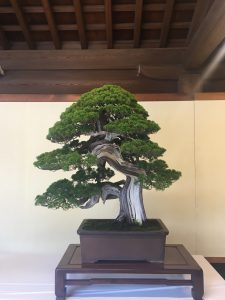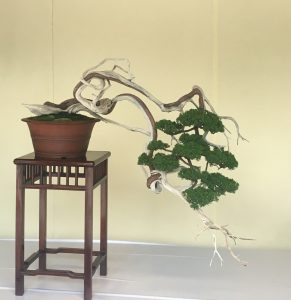I’ll start off with a quick translation, courtesy of Selinger-sensei’s friend Noto-san. 木(Ki) as you might guess from the idiom means “tree” and 森 (mori) means “forest” and is composed of three “tree” radicals. But, according to Noto-san, in the context of Shinto Shrines (神道神社; Shinto Jinja) and 鎮守の杜 (chinju no mori; forest of shrine), mori uses this kanji: 杜, combining the familiar “tree” radical (木) with the “earth” or “ground” radical (土) and implying “sacred ground.” Very interesting!
~~~
We began the day with Shinto and Shinto Shrines 101, a discussion and lecture led by Noto-san. We learned about the basic principles of Shinto and how kami can be found everywhere. According to Motoori Norinaga (1730-1801), “whatever seemed strikingly impressive, possessed the quality of excellence and virtue, and inspired a feeling of awe was called kami.” Noto-san joked that Selinger-sensei’s skill in and dedication to language study for her might be worthy of being called kami. I’ll quickly run down the basic components of a Shinto Shrine:
- Torii Gate (note, serious wordplay incoming: written as 鳥居, torii, using the kanji for “bird” and “stay,” it was originally written as 通り入る, tooriiru, using the kanji for “way” and “enter”…wordplay is wonderful)
- Name of shrine on a stone pillar
- Lanterns (とうろう)
- Kagura Shinto Dance and Music Hall
- Temizu Water Purification Place
- Komainu Stone Guardian Dogs
- Treasure House
- Hall of Worship
- Main Hall (Goshintai, or container for kami, enshrined)
- Sacred Tree
After the discussion, we were in for a serious treat: we visited Meiji Jingu Shrine and witnessed a full Shinto ceremony service/ceremony. Although my feet may or may not have fallen asleep with major pins and needles, it was a really interesting experience. Many of the ritual actions are associated with purification and dispelling evil spirits, and there was even a Kagura dance as well. I, myself, am not particularly religious or spiritual, but even so it was definitely a cool, moving experience.
~~~
So, you may be wondering (or not) at this point: “why the idiom for the title?” What might “mistaking the forest for the trees” (note to self: ask Aridome-sensei and Selinger-sensei how that might be translated into Japanese) have to do with Meiji Jingu Shrine? The simple, uninformative answer is that I am an ecologist and Meiji Jingu Shrine is surrounded by a forest. Let me explain: although was most certainly centered around the shrine and Shinto, I think probably the most fascinating and wonderful part of this whole trip is that each individual component can be approached from multiple angles, owing to our own individual interests. So for instance, I was absolutely fascinated to learn and talk about Meiji Shrine’s forest as an ecosystem with Tanaka-san, one of the forest caretakers. And evidently, Tanaka-san picked up on that enthusiasm and facination; our forest tour was originally only supposed to be a half hour, but was extended to an hour and a half as I just kept asking question after question. みんなさんごめん!でも、すごくおもしろかった!(Minna-san gomen! Demo, sugoku omoshirokatta! Apologies everyone, but it was extremely interesting!)
The Meiji Shrine Forest is actually not a “natural” forest but rather a manmade one. That is, in 1920, scientists planted a specific composition of conifers, evergreen broadleaf, and deciduous broadleaf trees imported from all over Japan and even overseas, knowing and projecting how that specific composition would change through ecological succession into the forest that it is today, 100 years later (i.e. stage 3 of 4 in the plan). The forest has largely been left untouched this entire time, even withstanding the Tokyo firebombings in WWII. And, as the canopy became more dense, the forest changed the microclimate of that area from a dry and barren to humid and cool. Even if it was “artificially planted,” I would argue that the forest, left to its own devices all these years, is most certainly a natural ecosystem. Going back to the idiom, though, ecologists, I think, pride themselves on viewing the big picture, while at the same time focusing on the interactions and connections between organisms and their environment. So I think we at times mistake the forest for the trees and get lost in the details, but at other times we mistake the trees for the forest and take a broader picture. Speaking of the broader picture, these certainly are not my full and complete thoughts and notes from my discussion (translation courtesy of Selinger-sensei) with Tanaka-san; so, this entry is “mistaking the trees for the forest” and capturing the big ideas from the day. As I’m sure any of my peers or the sensei’s can attest, I was furiously scribbling down notes and observing the forest and asking Tanaka-san questions, so I think it’d be a shame not to document it, if people would be interested in reading.




